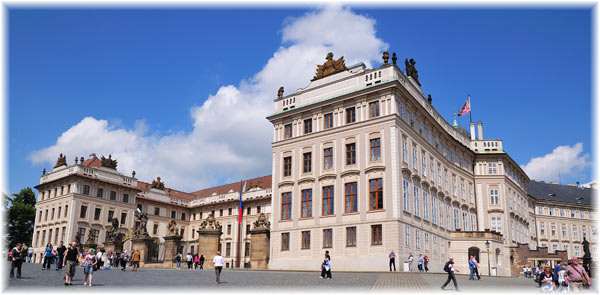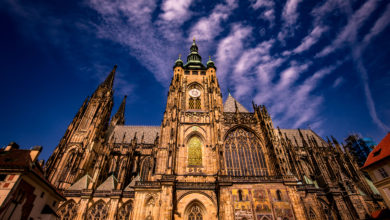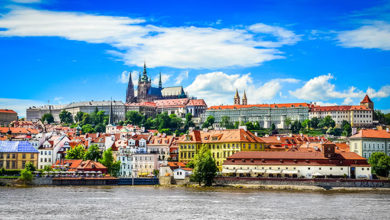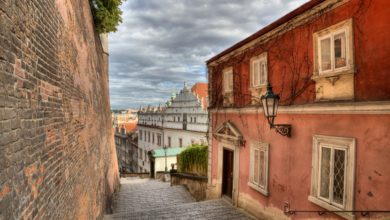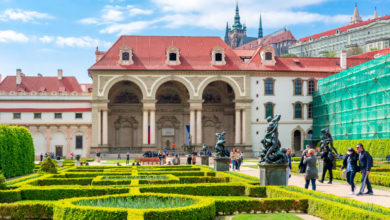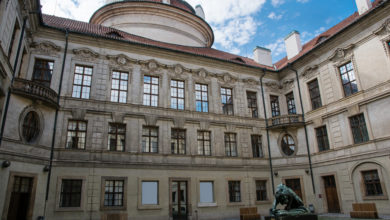Prague Castle Sights
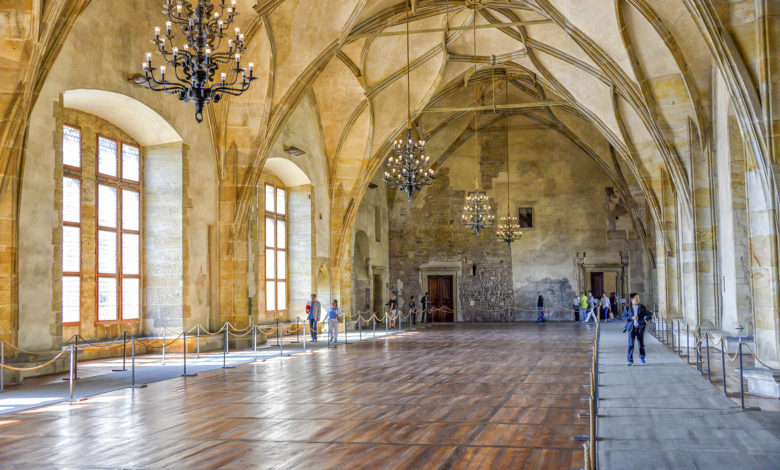
The one sight that should be on everyone’s list no matter how much or how little time you have in Prague should be Prague Castle. This building is more than just a castle; it is also a network of outer buildings and beautiful courtyards.
The Archbishop’s Palace
Standing to the right of the gate to Prague Castle, it is baroque in style with a pale yellow Rococo façade. In the centre of this façade sits the archbishop’s coat of arms. Inside, the interiors are beautiful, but especially so for the chapel and gallery. The palace is still in use today by the Archbishop of Prague.
Courtyards
The first courtyard is easily accessed through Hradcany Square. However, this was not always the case as at one point, the courtyard was separated by a moat and could only be entered by using a drawbridge. This natural moat was actually one of three that originally protected the castle. You can enter this courtyard by going through a gate decorated with statues of Fighting Giants and guarded by two castle guards. This courtyard is also completely closed in by buildings. You can exit this courtyard into the second one using the Matthias Gate, which was the original entrance to the castle itself. When going through the gate, a staircase leads to representative rooms of the casts now used by the Czech president.
The second courtyard was created in the 16th century on a buried moat. Here, visitors will find Kohl’s Fountain along with St. Cross Chapel. In addition, most of the northern part of the courtyard was developed by Emperor Rudolf II. Since Rudolf was a great art lover, he used the stables to store much of his art by adding a second floor above the stable and building to grand Renaissance halls, including the Spanish Hall and the Gallery. Today, the Prague Castle Picture Gallery is located in what used to be the stables and houses a small portion of Rudolf’s art collection. When the Galley was being renovated, workers came across the remains of the first church at the castle to be dedicated to the Virgin Mary. Dating back to the 9th century, this church was only the second Catholic Church in Czech lands.
Entrance to the third courtyard is gained through a passageway in the east wing. This entire courtyard was paved in the 1920s and now covers the remains of the original medieval structures such as a church and graveyard. The most important feature here is the Cathedral of St. Vitus, known as the largest Christian church in Prague and the final resting place of numerous kings and the home of the crown jewels.
Prague Castle Picture Gallery
Located on the old stables in the second courtyard, the Picture Gallery today contains part of Rudolf’s II art collection. The gallery itself was created in 1965 and houses just a small part of what was at one time a collection of over 30,000 pieces of artwork. Known as a highly educated man, Rudolf surrounded him with some of the brightest minds of the time, including sculptors, painters, craftsmen, alchemists, doctors and astronomers. With such wide interests, the emperor collected artefacts and artists such as minerals, clocks, measuring equipment, mechanical toys, stuffed animals, books, gold and many more. Not only was his collection of precious stones considered to be one of the most valuable at the time, so was his art collection. Many well-known individuals worked under Rudolf, including artists such as Raffael, Cranach and Tintoretto. Others included such astronomers as Tychon de Brahe and Jan Kepler. Rudolf so loved his knowledge that he often took part in experiments and could often get so involved that he would forget to rule his land. One result of this was the Thirty Years War which began in 1648 and cost Rudolf much of his collection as Swedish troops stole it. However, there are still plenty of noteworthy items on display, such as Tintoretto’s The Whipping of Christ and Ruben’s Assembly of Olympic Gods. There are also works by many others on display.
Spanish Hall
The Spanish Hall is also a famous spot located at Prague Castle. Build by Rudolf II; the first floor was the largest secular room in the castle. Rudolf had it constructed to house his sculpture collection, but today it is used as a gathering place for political and social events. The interior of the Spanish Hall dates back to the 17th century and has undergone numerous renovations throughout the years.
The Royal Palace
Located to the south of the Cathedral of St. Vitus, the Royal Palace is one of Prague Castle’s oldest structures. Throughout the years, it has been the scene of several histories making events. For example, in 1618, the so-called Prague defenestration took place here, as did the death sentence of 27 anti-Habsburg rebels in 1621. This palace was not built all at one time but rather over many centuries in three main stages. The building that stands now is also built over an 11th-century Romanesque palace that now forms the current palace’s cellar. The most significant construction took place toward the end of the 15th century when architects linked the earlier spaces and created one large space.
Vladislav Hall
Vladislav Hall is also an important part of Prague Castle and today is used for important state occasions. It is made of two distinctly different architectural styles with Renaissance windows and entrances but a Gothic ceiling. This hall used to be called the Great Throne Hall and was originally used for special occasions such as coronations, feasts, and even jousting tournaments. When Rudolf II was emperor, it was used as an art market.
Basilica of St. George
The Basilica of St. George is still the best-preserved Romanesque place of worship in the city. While the basilica is a lovely sight, it does contain one small blemish. That is that the twin spires do not have the same proportions. Adam, or the south spire, is larger than the slimmer north spire named Eva. Inside the basilica are the final resting spots of numerous Czech royalties, including two princes whose graves go all the way back to the 10th and 11th centuries. Also located here are numerous Romanesque murals and a Gothic statue depicting the Virgin Mary and Christ. The vaulting still bears the Romanesque frescoes from the mid 13th century. The convent of St. George was at one point a centre of scientific research and housed a room where manuscripts were copied. In fact, this convent was so important that the abbess had the right to crown Czech queens alongside the archbishop. Today, it is used to house the National Gallery’s collection of art from several different periods. Those art collections are organized in chronological order. With the ground floor housing art from the 14th century, the second floor has art from the 15th and 16th centuries, and the third floor houses Mannerism and baroque works.
Golden Lane
Located behind the Convent of St. George is the Golden Lane. It gets its name from the goldsmiths that lived here in the 17th century. The area is not only picturesque but is also surrounded by numerous myths and legends. For example, many of the legends surround the alchemists who were trying to make s stone of wisdom that would transform ordinary metals into gold and make the owner immortal at the same time. One alchemist, in particular, fueled these legends. Mr Uhde lived on Golden Lane around 1830 and was known for being slightly off centre. He would wear a long black coat and had a long white beard. He was constantly trying to develop a stone of wisdom, and one night his lab suffered an explosion and created a fire. The professor suffered a stroke, and he died with a smile while holding a nugget of pure gold. In later years, Golden Lane attracted the poor, and the name Golden became more ironic than anything else. It was said that there was only one toilet and an open sewer ran down the middle of the lane at the time. Around the turn of the 19th century, Golden Lane was renovated, and several famous writers took up residence, including Franz Kafka and Nobel Prize-winning poet Jaroslav Seifert.
Lobkovicz Palace
Located next to the easternmost gate into Prague Castle, the Lobkovicz Palace was built after a fire in 1541. However, it gets its current looks from the 17th century when it was rebuilt for the Lobkovicz family. The banquet hall is the largest and still sports the mythological paintings from the 17th century. On the other side of the palace is the Black Tower, which was an original part of the fortifications and later turned into a debtor’s prison.
The Ledeburg, Furstenberg and Palffy Gardens
These gardens are located in spots that would have one point been working vineyards, but in the 16th century, the nobility began to use the same ground for terraced gardens. These three gardens were then joined together to create one large one. Created in 1784, the Furstenberg Garden was decorated with statues and classic vases. The Palffy Garden still contains a sundial painted at the top of the staircase. The Ledenburg Garden is home to a stunning sala terrena, and all can be accessed from the Palffy Palace and are well worth the trip.
The Wallenstein Palace
Located opposite the Ledeburg Palace, this was one of the first baroque buildings in Prague. It was built by Kuke Albrecht von Wallenstein as a private residence. Wallenstein had come to the forefront in the Thirty Years War when he sided with the king and took property belonging to the defeated Czech nobility. In actuality, Wallenstein changed sides many times during the war, but he kept building his property along the way. His luck finally ran out when he was murdered in 1634 when he began thinking of a way to take the imperial crown away from the Habsburgs. However, his palace still lives on today. The main façade is simple and has both Renaissance and baroque touches. The Main Hall is the castle’s highlight and is two stories high and decorated with stucco and ceiling work depicting Wallenstein as the god Mars. Located next to the main building is a garden and park along with a man-made dripstone cave.

